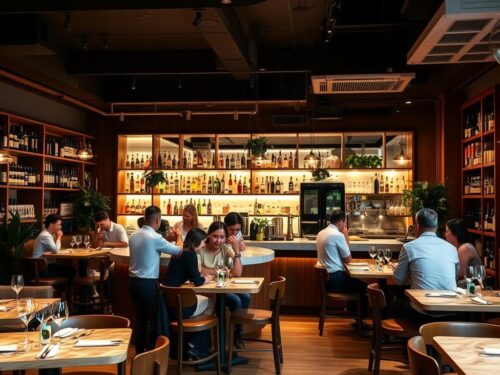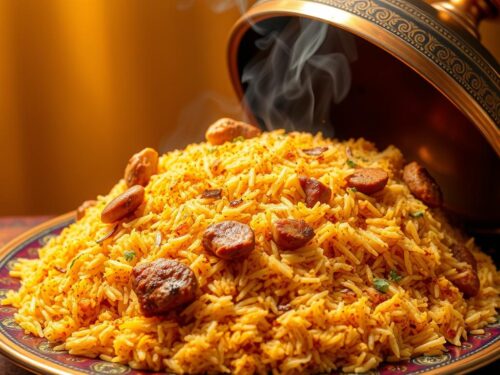Singapore shines as a global food hub, blending street flavors with Michelin-starred excellence. With 49 starred venues, the city offers unforgettable meals from French brasseries to Sri Lankan kitchens.
Keong Saik Road leads the charge as a hotspot for creative chefs. Establishments like Labyrinth push boundaries with locally sourced ingredients, while Cloudstreet wows with sustainable seafood.
Many featured spots appear on Asia’s 50 Best lists. Some even served as backdrops in Crazy Rich Asians, adding cinematic glamour to their appeal.
Key Takeaways
- 49 Michelin-starred venues showcase culinary diversity
- Keong Saik Road emerges as a gourmet destination
- Sustainability drives menus at leading establishments
- Multiple Asia’s 50 Best restaurants featured
- Filming locations add cultural significance
Introduction to Singapore’s Fine Dining Scene
From hawker stalls to haute cuisine, Singapore’s food scene offers an unmatched culinary journey. The city’s strict cleanliness laws ensure pristine kitchens, whether at a street-side hawker center or a Michelin-starred venue. This duality—where satay skewers share the spotlight with truffle-laced dishes—defines its gastronomic identity.
Why Singapore is a Culinary Hotspot
With just 1% farmland, chefs innovate relentlessly with ingredients flown in globally or foraged locally. Restaurants like Labyrinth source 90% of their produce from nearby farms, turning constraints into creative triumphs. Meanwhile, the city’s port history infuses menus with spices and techniques from across Asia.
What Makes Fine Dining Unique Here
Colonial mansions like Zén’s three-story home blend architecture with cuisine, while Burnt Ends pairs smoky BBQ with a chic cocktail bar. Legal quirks—like the gum ban—shape a culture where every bite is intentional. At Cure, Irish flavors meet Peranakan spices, proving Singapore’s talent for reinvention.
Among the best restaurants, venues with michelin stars thrive alongside Maxwell Food Centre’s $3 chicken rice. It’s this harmony of high and humble that keeps food lovers returning.
Burnt Ends: A Modern Australian BBQ Experience
Chef Dave Pynt’s relocated Dempsey Hill hotspot redefines barbecue with inventive dishes and dry-aged perfection. Now flanked by a bakery and cocktail bar, the venue turns smoky theatrics into an immersive dining affair.
Signature Dishes to Try
The secret menu stars uni toast crowned with king crab and a playful take on *steak frites*—crispy potato cake paired with wagyu tartare. For a sweet-savory twist, the signature beef marmalade glazes slow-cooked brisket in spiced sauce.
The Chef’s Counter Experience
Snag one of 20 seats at the kitchen counter to watch flames dance across dry-aged ribs and strip loin. Pro tip: Order the bone marrow bun, a buttery foil to the smoky mains. Can’t land a reservation? The cocktail bar serves smaller bites alongside crafted drinks.
Chef Pynt’s bold flavors have shaped Singapore’s BBQ scene, proving fire and finesse can coexist.
Odette: French Cuisine with a Personal Touch
Three-Michelin-starred Odette blends elegance with personal storytelling. Nestled in the National Gallery, Chef Julien Royer’s michelin-starred restaurant pays homage to his grandmother’s recipes while showcasing seasonal ingredients. Dishes arrive like edible art, with rosemary smoke enhancing the drama.
Chef Julien Royer’s Culinary Vision
Royer’s dishes whisper nostalgia. The famed rosemary-smoked organic egg arrives tableside, its creamy yolk hiding beneath a fragrant cloud. *Every plate reflects his childhood*, from delicate Brittany turbot to pigeon glazed with *grandmother’s* blackberry sauce. Even the china mirrors her floral patterns.
Sustainability anchors the menu. Line-caught fish and locally foraged herbs star in an 8-course tasting menu that changes monthly. The 1,800-bottle wine cellar offers pairings like aged Burgundy with duck liver tart.
Must-Try Tasting Menu
The evening course unfolds like a gourmet sonnet. Highlights include Hokkaido uni with yuzu and a chocolate-hazelnut desserts finale. Lunch skips two courses but keeps the egg ritual—a perfect intro for time-pressed guests.
| Menu Feature | Dinner | Lunch |
|---|---|---|
| Courses | 8 | 6 |
| Rosemary Egg | Yes | Yes |
| Price Range | $380++ | $250++ |
| Wine Pairing | Optional | Optional |
Ranked among Asia’s 50 Best Restaurants, Odette turns meals into memories. Book weeks ahead—this is where culinary dreams come true.
Zén: Scandinavian Flavors in a Colonial Setting
Bukit Pasoh Road hides a culinary gem where reindeer blood pancakes share the menu with caviar chawanmushi. Inside a three-story colonial mansion, Zén merges Stockholm’s precision with Singapore’s vibrant pantry. The result? A meal that feels both familiar and thrillingly new.
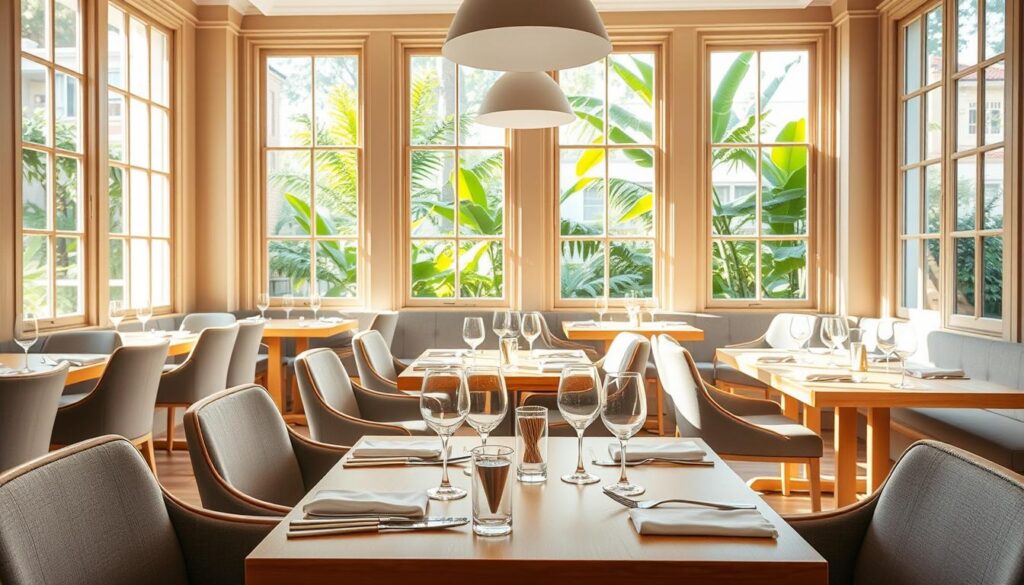
Multi-Level Dining Experience
The experience unfolds across floors like a gourmet adventure. Guests start in the lounge with truffle French toast, a nod to Zén’s sister restaurant in Sweden. Next, the main dining room showcases smoked scallops using Nordic techniques adapted to tropical ingredients. The finale? A dessert salon serving cloudberry parfait atop Peranakan-inspired tiles.
Asian-Inspired Scandinavian Dishes
Chef Björn Frantzén’s cross-continent collaboration shines in dishes like the seasonal reindeer blood pancake, paired with pickled lingonberries. The tasting menu surprises with sake-matched courses, such as miso-glazed cod beside juniper-smoked venison. Even the interiors blend Nordic minimalism with vibrant local motifs—a feast for the eyes and palate.
| Dining Phase | Highlight | Pairing Suggestion |
|---|---|---|
| Lounge | Truffle French toast | Champagne |
| Main Dining | Smoked scallops | Dry sake |
| Dessert Salon | Cloudberry parfait | Earl Grey tea |
Pro tip: Book the chef’s counter to watch Frantzén’s team artfully torch juniper branches for tableside smoking—an unforgettable sensory twist.
Cloudstreet: Sri Lankan Cuisine with a Twist
Amoy Street’s historic shophouses set the stage for Cloudstreet’s bold reinvention of Sri Lankan flavors. Holding two michelin stars, Chef Rishi Naleendra crafts dishes like charred venison with pickled cashew—a harmony of fire and spice. The molasses-glazed stout bread alone justifies the hype.
U-Shaped Counter and Open Kitchen
Fourteen seats curve around the action, offering front-row views of flaming pans and artful plating. Each course arrives on handmade plates, like the black pork curry with jackfruit—slow-cooked in cinnamon and cardamom. The counter’s intimacy turns meals into immersive theater.
Local Ingredients and Sustainable Practices
Naleendra’s “no waste” philosophy shines in partnerships with Sri Lankan spice growers. Over 80% of produce comes from regional farms, even in the vegan menu starring smoked eggplant and coconut ash. Desserts reuse coffee grounds for chocolate truffles—proof that luxury and ethics can coexist.
Pro tip: Book early for the chef’s counter. Watching the team torch juniper branches for tableside smoking is as memorable as the food itself.
Labyrinth: Reinventing Singaporean Classics
At Labyrinth, childhood flavors get a futuristic makeover through Chef LG Han’s inventive techniques. Nestled on Raffles Avenue near the Esplanade theaters, this Michelin-starred venue transforms hawker staples into avant-garde masterpieces. Every dish tells a story—like their chili crab reimagined as airy foam with crispy soft-shell crab.
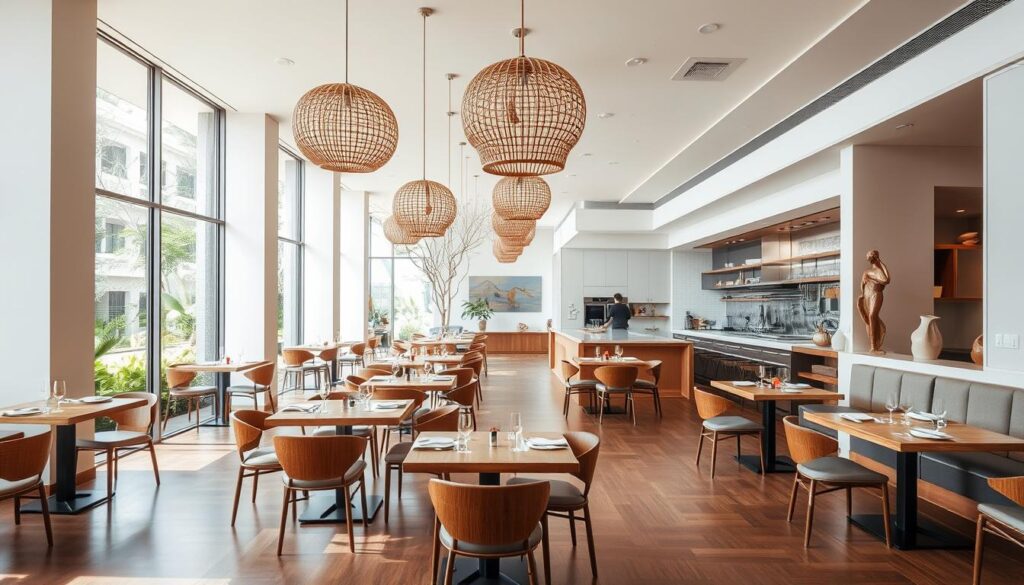
Modern Takes on Traditional Dishes
The menu plays with nostalgia through techniques like molecular gastronomy. Their signature deconstructed kaya toast pairs coconut ice cream with caramelized brioche crumbs, capturing breakfast memories in a cooking revolution. Even the humble fish head curry becomes delicate morsels wrapped in banana leaf foam.
Chef Han documents family recipes to preserve heritage while innovating. “We’re not erasing the past,” he explains, “we’re writing its next chapter.” Seasonal ingredients like blue pea flowers and torch ginger get spotlighted in ever-changing tasting menus.
Chef LG Han’s Sustainability Efforts
Over 90% of local produce comes from urban rooftop farms and ethical suppliers. Food scraps become broths in a closed-loop system, minimizing waste without sacrificing flavor. The team even repurposes coffee grounds as fertilizer for their herb garden.
This commitment to sustainability extends beyond the kitchen. Menus are printed on seed paper, and staff uniforms use recycled fabrics. It’s gourmet dining that cares—for both tradition and tomorrow.
Imperial Treasure Super Peking Duck: A Roasted Delight
The art of roasting duck reaches new heights at Imperial Treasure Super Peking Duck. Nestled in Paragon shopping mall, this spot turns a classic dish into an event-worthy experience. Their secret? A 48-hour prep process ensuring skin so crisp it shatters.
Why Pre-Ordering is Essential
Plan ahead—whole roasted duck requires 24-hour notice. The kitchen air-dries the bird overnight, then slow-roasts it with a glaze of malt syrup for that iconic caramelized finish. Groups of 4–6 get the most from the feast, but solo diners can opt for takeaway portions.
Two roasting styles dominate: Beijing (crispier skin) and Cantonese (juicier meat). Watch chefs demonstrate pancake-making tableside, a playful touch that adds to the date-night appeal.
Pairing Suggestions
Balance rich flavors with Tsingtao beer or earthy oolong tea. For wine lovers, a bold red complements the duck’s savory notes. Don’t skip the hoisin sauce drizzle—it ties every bite together.
Pro tip: Book for lunch to enjoy daylight views of Orchard Road while savoring this expert Peking duck recommendation. Leftovers? They pack beautifully for a next-day snack.
Esquina: Playful Spanish Tapas in Chinatown
Tucked into a Chinatown corner, Esquina turns Spanish tapas into a culinary adventure. The intimate 40-seat space buzzes with energy, where chefs prepare dishes like “Spanish nigiri” right before your eyes. Exposed brick walls and an open kitchen create a convivial vibe perfect for sharing plates.
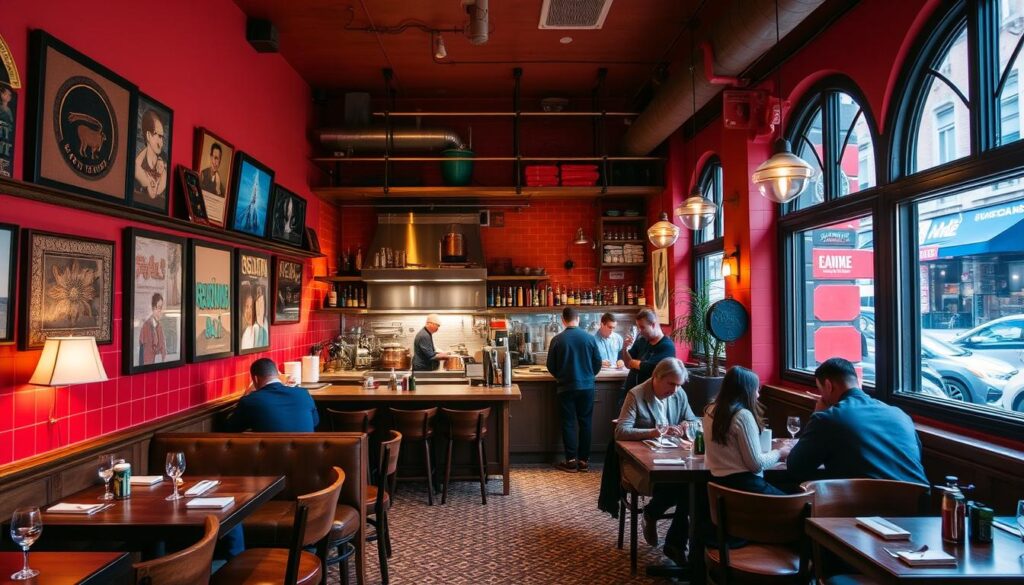
Molecular Gastronomy Influences
Chef Carlos Montobbio, an El Bulli alum, brings avant-garde techniques to traditional flavors. His liquid olives burst with briny intensity, while spherified gazpacho resembles edible pearls. The sangria sorbet—frozen tableside with liquid nitrogen—showcases his playful approach to desserts.
Don’t miss the bacalao brandade served as sushi-style bites. Salted cod gets whipped into airy perfection, topped with crispy fish skin for texture contrast.
Best Dishes for Sharing
Groups should order the Iberico pork pluma, its smoky paprika crust balanced by sweet roasted peppers. The octopus with black garlic aioli disappears quickly, as does the grilled prawn with romesco sauce.
For drinks, try vermouth-based cocktails or Spanish wine from their curated list. The private dining room (hidden behind a bookshelf) offers an exclusive experience for up to 10 guests.
Pro tip: Weekday lunches feature abbreviated menus perfect for office workers—think gambas al ajillo with crusty bread in under 45 minutes.
Cure: Irish Cuisine Meets Singaporean Flavors
Where Irish whiskey meets Peranakan spices, Cure crafts a culinary dialogue between Dublin and Singapore. Chef Andrew Walsh transforms his heritage into inventive plates at this Keong Saik Road hotspot, where exposed brick walls and a U-shaped counter create an intimate dining vibe. The menu reads like a passport—black pudding gets paired with kimchi mayo, while white asparagus shines with burrata ice cream.
Chef Andrew Walsh’s Creative Dishes
Seasonal ingredients take center stage in Walsh’s playful riffs on tradition. His signature black pudding croquette surprises with crispy exteriors giving way to spiced blood sausage, all balanced by tangy kimchi mayo. For dessert, the “Irish coffee” reimagines the classic with whiskey gel and coffee soil—a textured homage to Dublin’s pub culture.
Monthly collaborative dinners spotlight EU chefs, like a recent Nordic-Irish fusion event featuring peat-smoked milk ice cream in charcoal poori. Weekend brunch brings soda bread innovations, including a version stuffed with Cashel Blue cheese and organic egg yolk.
Natural Wine Pairings
The beverage program champions biodynamic producers like Austria’s Gut Oggau. Sommeliers guide guests through natural wine flights that complement the bold flavors—think skin-contact whites with silverhill duck, or earthy reds alongside mushroom-laced dishes.
As Welsh notes, “The acidity in these wines cuts through rich dishes like our brown crab with fermented chili.” The 8-seat chef’s counter offers the full experience, where multi-course tasting menus unfold with theatrical plating.
Meta Restaurant: Innovative Asian Fusion
Mohamed Sultan Road hosts a culinary laboratory where Korean koji meets Iberico pork in unexpected harmony. At Meta, Chef Sun Kim—trained in Kyoto’s precision kitchens—reimagines Asian flavors through fermentation and fire. The 12-seat chef’s counter turns meals into front-row experiences, with dishes like koji-cured salmon served atop handmade ceramic plates.
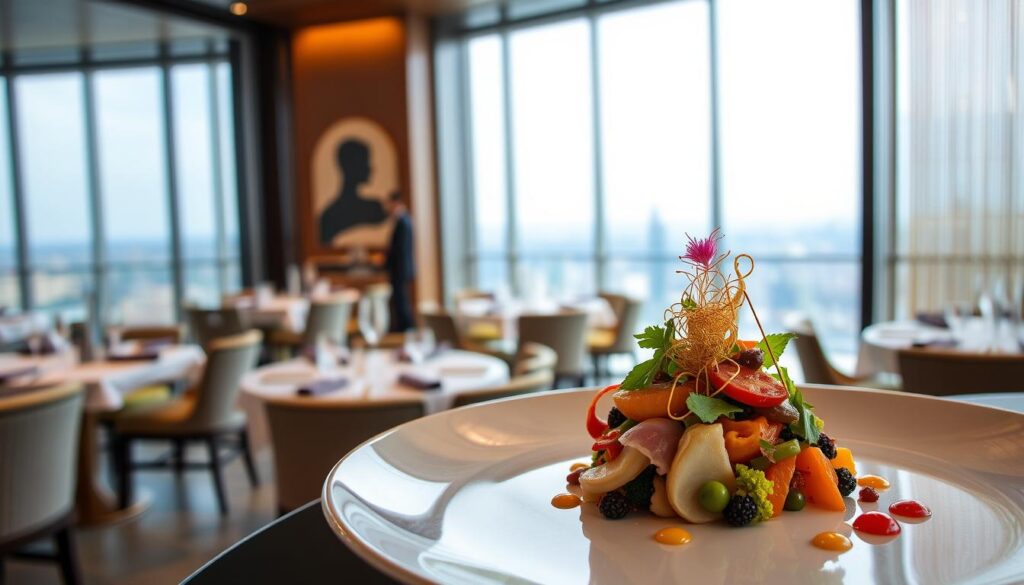
Seasonal Tasting Menus
Every month brings a new theme, like the monsoon menu starring mud crab with tamarind foam. The rooftop herb garden supplies garnishes, from shiso leaves to edible flowers. Tea pairings—curated with TWG—include smoky oolong to complement the Iberico pork Char Siew, glazed with red yeast rice.
| Season | Highlight Dish | Tea Pairing |
|---|---|---|
| Monsoon | Mud crab, tamarind foam | Jasmine Silver Needle |
| Harvest | Koji-aged duck, plum sauce | Earl Grey Moonlight |
| Spice | Rendang croquette | Chai Masala |
Chef’s Table Experience
Reservations for the counter open 60 days ahead. Diners watch Kim’s team torch juniper branches for tableside smoking—a nod to his Kyoto roots. The course culminates in a dessert of miso caramel with rooftop honey, a sweet homage to local ingredients.
Pro tip: Book the 6:30 PM slot for twilight views of the herb garden. Leftovers? Unlikely—every bite is engineered to disappear.
Les Amis: A Legacy of French Excellence
Les Amis stands as a beacon of French culinary tradition in the heart of the city. For 25 years, this iconic restaurant has paired classic techniques with subtle Asian twists, earning a loyal following among gourmands. The mahogany-clad dining room and crisp white linens set the stage for an unforgettable experience.
Wine Cellar Highlights
Sommeliers curate a 1,300-label list, starring rare Burgundy verticals and a private wine vault showcasing Château Lafite. The cellar’s crown jewel? A 1990 Romanée-Conti, poured by the glass for special occasions. Pair it with the truffle-stuffed pigeon ballotine—a dish draped in velvety sauce.
Classic French Dishes with a Twist
Butter-poached lobster gets a local accent with laksa leaf emulsion, while the cheese trolley features Asian-infused varieties like durian brie. The lunchtime prix-fixe menu offers surprising value, including a three-course spread with optional wine pairings.
Pro tip: Book the private room for its floor-to-ceiling wine display. Anniversary menus revisit 1990s classics, like the original foie gras terrine with Sauternes gelée.
Hashida Sushi Singapore: Authentic Japanese Omakase
Master sushi chef Kenjiro Hashida brings decades of Edomae tradition to Singapore’s vibrant culinary landscape. His 12-seat counter delivers a meal where Tokyo-Toyosu market fish meets razor-sharp precision. Each 20-piece omakase unfolds like edible poetry, from Hokkaido uni to Nagasaki eel.
Freshness and Precision
Ingredients arrive daily via chilled air freight, with tuna aged in-house for optimal texture. The team hand-grates wasabi tableside, its heat perfectly balancing fatty otoro. “We treat each fish like a seasonal canvas,” notes Chef Hashida, who trained under a third-generation sushi master in Ginza.
Winter brings snow crab with yuzu zest, while summer highlights sweet ayu fish. Even the shari (sushi rice) changes subtly—warmer in cold months, vinegared brighter for summer.
Chef’s Special Selections
The counter experience peaks with rare finds like kuruma ebi brushed with smoked sea salt. Pairings matter: try junmai daiginjo sake with scallop or earthy sencha with amberjack. First-timers should note:
- Phones stay away—the counter demands full attention
- Nigiri is eaten immediately after plating
- Ginger cleanses the palate between pieces
Chef Hashida’s apprenticeship story surfaces in details—like the 100-day rice apprenticeship he endured before touching fish. Today, that rigor translates into Singapore’s most transportive sushi experience.
Nouri: Crossroads of Global Flavors
At Nouri, boundaries between cuisines dissolve into a harmonious global feast. Chef Ivan Brehm’s “Dishes Without Borders” concept turns Amoy Street’s historic shophouse into a culinary passport office. Here, Amazonian priprioca root might share a plate with Japanese bonito flakes—each bite celebrating migration stories.
Culinary Diplomacy in Action
The chef trains staff through “flavor memory” exercises—blind tastings that sharpen ingredient recognition. “We don’t fuse cultures,” Brehm explains, “we find their natural meeting points.” The open kitchen showcases this philosophy, where chefs prepare Brazilian tapioca alongside Kyoto-style dashi.
Monthly collaborations bring international talents to the counter. Recent guest chefs have included a Oaxacan mole specialist and a Korean fermentation expert. The lunchtime bento box—changed weekly—offers an affordable taste of this globetrotting experience.
Unexpected Flavor Bridges
Nouri’s menu reads like a gastronomic atlas. The team sources rare ingredients to create surprising harmonies:
| Base Ingredient | Unexpected Pairing | Origin Story |
|---|---|---|
| Brazilian tapioca | Japanese dashi | Chef’s Tokyo training |
| Scottish scallops | Indonesian kecap manis | Maritime trade routes |
| Peruvian cacao | Malaysian gula melaka | Colonial sugar history |
The “Pay It Forward” initiative lets diners sponsor meals for underprivileged food workers. It’s cooking without borders in every sense—where every dish builds bridges between cultures and communities.
Restaurant Euphoria: A Symphony of Flavors
A delicate snowfall of lychee crystals sets the tone at Restaurant Euphoria, where every dish tells a seasonal story. Located on Tras Street, this intimate venue turns meals into performance art—from tea-smoked scallops presented under glass cloches to desserts that literally shimmer.
Where Art Meets Gastronomy
Local painters and ceramicists collaborate on custom plating for the 10-course “Ode to Seasons” menu. Summer might arrive on a hand-thrown plate painted with monsoon clouds, while autumn courses nestle in edible leaf bowls. The showstopper? A lychee granité that “snows” when hot elderflower syrup is poured tableside.
Even cocktails become canvases. Ice cubes embedded with violets or orchids slowly reveal floral patterns as they melt. Chef Jason Tan credits his herb spiral garden—visible from the dining room—for inspiring these living garnishes.
Seasonal Stories on the Plate
Tea-smoking techniques transform simple ingredients into complex flavors. Diners watch as oolong-infused smoke swirls around duck breast, adding earthy depth. The kitchen adapts the experience for vegetarians too, swapping proteins for heirloom carrots smoked with lapsang souchong.
Highlights from the current seasonal rotation:
- Chrysanthemum-fed chicken with fermented honey glaze
- Sakura ebi crackers topped with mountain yam foam
- Herb garden mint sorbet served on frozen river stones
“We treat each season like a new chapter,” says Tan, who changes the menu quarterly. Reservations book weeks ahead—especially for counter seats facing the open kitchen’s culinary theater.
Keong Saik Road: A Hub for Best Fine Dining Singapore
Five blocks of Keong Saik Road pack more Michelin stars than some countries. This historic strip has become Singapore’s most concentrated roster of culinary talent, where restored shophouses host boundary-pushing kitchens. The area’s charm lies in its contrasts—century-old tiles frame modernist plating, while hawker scents mingle with truffle aromas.
Culinary Heavyweights
At one end, Cure reimagines Irish pub fare with Peranakan spices—their black pudding croquette with kimchi mayo draws queues. Down the block, Thevar’s Indian-Malay tasting menus showcase chef Manogren’s knife skills at the open counter. Don’t overlook KēSa House, where weekend brunch means kaya soufflé pancakes.
| Feature | Cure | Thevar |
|---|---|---|
| Menu Style | Irish-Singaporean fusion | Modern Indian |
| Signature Dish | Blood sausage croquette | Blue crab rasam |
| Dining Duration | 2 hours (à la carte) | 3 hours (tasting) |
| Best For | Creative cocktails | Spice exploration |
Beyond the Plate
Hidden cocktail den Live Twice serves yuzu-infused martinis behind an unmarked door. The area’s conservation efforts shine through details—original plaster moldings at Thevar, restored swing doors at Meta. Just 500 meters away, Chinatown Complex offers $3 chicken rice for post-feast contrast.
Walking tours reveal architectural gems between meals. Arrive early—limited street parking gives way to convenient CBD MRT access. Pro tip: Thursday nights buzz with chef pop-ups at the adjacent Neil Road eateries.
From heritage cocktails to avant-garde tasting menus, Keong Saik Road proves great flavors need no sprawling space. Its compact footprint delivers Singapore’s most thrilling gastronomic microcosm.
Conclusion: Your Guide to Singapore’s Best Fine Dining
From smoky BBQ pits to delicate sushi counters, Singapore’s culinary landscape dazzles with variety. Whether savoring French truffle-infused dishes or Sri Lankan spice explosions, each restaurant offers a unique experience.
Plan ahead—book 2–8 weeks for top spots like Odette or Burnt Ends. Dress codes range from smart casual to jackets-required. Tasting menus span $150–$380, with seasonal highlights during July’s global food festivals.
For a 3-day trip, balance rich meals with Maxwell Centre’s chicken rice. Pro tip: Alternate multi-course dinners with light hawker bites to fully appreciate the city’s flavors.


